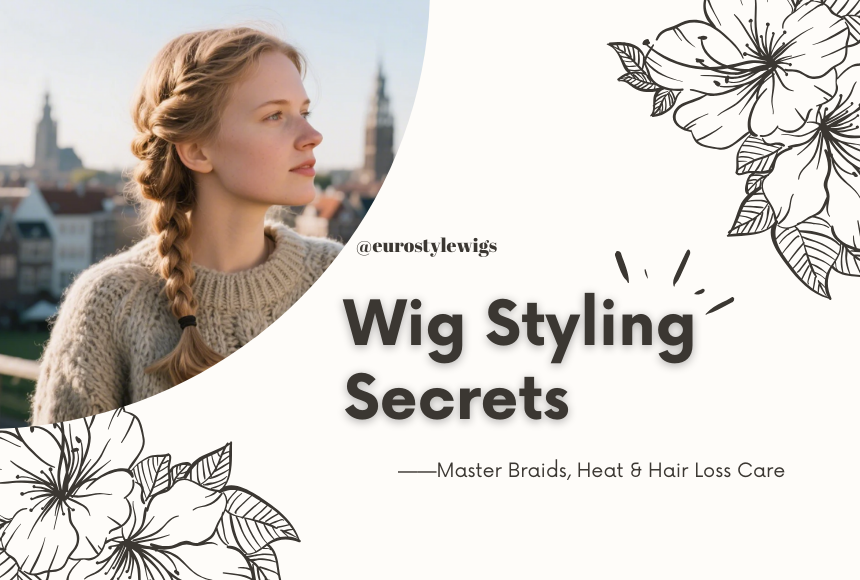Human hair wigs are a revolutionary blend of artistry and practicality—ideal for hair loss recovery, protective styling, or simply reinventing your look. Unlike synthetic options, they mimic natural hair’s texture, respond to heat tools, and allow endless creativity. In this guide, you’ll learn to style human hair wigs like a pro, with a focus on braided hairstyles, heat-based techniques, and compassionate solutions for thinning hair.
1. Choosing Your Human Hair Wig: Start Strong
The right wig sets the stage for flawless styling. Prioritize these features:
• 100% Virgin/Remy Human Hair: Cuticles aligned to reduce tangling; accepts dyes and heat up to 350°F.
• Lace Front or Lace Closure: For realistic hairlines—essential for braids, ponytails, or updos.
• Lightweight Cap Construction: Breathable monofilament or hybrid caps reduce pressure on sensitive scalps.
• Density Matters:
▫ 130–150% Density: Natural-looking volume for daily styles.
▫ 180%+ Density: Best for thick braids or bold curls.
For Hair Loss: Opt for adjustable straps and removable combs.
2. Pre-Styling Essentials: Protect & Prep
Wash Wisely
• Use sulfate-free shampoo in cool water.
• Condition with a lightweight, silicone-free formula—focus on ends.
• Air-dry on a wig stand to preserve cap shape.
Detangle Gently
• Spray with a leave-in conditioner.
• Start combing from the ends, moving upward with a wide-tooth comb.
Heat Prep
• Apply thermal protectant spray before any hot tools.
• Set tools to 280–320°F (human hair burns above 350°F).
3. Styling Techniques: From Braids to Blowouts
A. Heat Styling for Everyday Glam
1. Sleek Straight Hair
▫ Flat iron small sections in a downward motion.
▫ Lock in shine with argan oil on the ends
2. Voluminous Curls
▫ Wrap 1-inch sections around a tapered curling wand.
▫ Pin curls while warm to boost longevity.
3. Beachy Waves
▫ Braid damp hair into loose plaits overnight.
▫ Undo in the morning for heat-free texture.
B. Braided Hairstyles: Beauty Meets Practicality
Human hair wigs allow braiding without damaging natural hair.
1. Protective Box Braids
▫ Part the wig into small squares.
▫ Attach kanekalon extensions for length.
▫ Braid close to the scalp but avoid tension on the lace front.
2. Dutch Braids for a Bold Look
▫ Start at the crown, weaving sections under the center.
▫ Secure ends with clear elastic; tuck under for an updo.
3. Goddess Braids
▫ Create large, flat cornrows with a side part.
▫ Accessorize with gold cuffs or hair rings.

Pro Tip: For scalp realism, choose a wig with a pre-plucked hairline and baby hairs.
C. Updos & Half-Styles
• Low Chignon: Twist hair into a loose bun; secure with U-pins.
• Half-Up Space Buns: Tease the crown for playful volume.
• Braided Crown: Dutch braid two front sections and pin at the nape.

4. Caring for Styled Wigs
• Avoid over-styling: Limit heat tool use to 2–3 times weekly to prevent dryness.
• Nighttime care: Store the wig on a stand or mannequin head to maintain its shape.
• Refresh braids: Spritz with a water-conditioner mix to revive texture between washes.
5. Addressing Hair Loss Concerns
For those managing hair loss, human hair wigs provide a seamless, confidence-boosting solution:
• Choose adjustable caps: Ensure a snug, irritation-free fit.
• Consult a stylist: Customize the wig’s parting or density to match your natural hair pattern.
• Protect existing hair: Wear a silk or satin wig liner to reduce friction and promote scalp health.
Final Thoughts
Human hair wigs empower you to reinvent your look daily—whether you’re rocking bold braids, elegant updos, or effortless waves. With proper care and creativity, your wig can become a versatile extension of your personal style.





